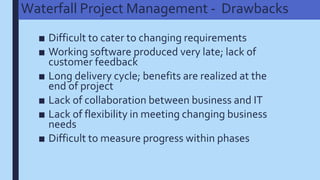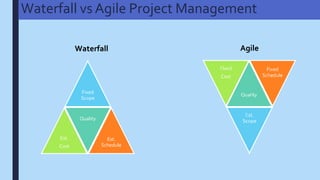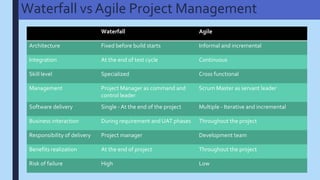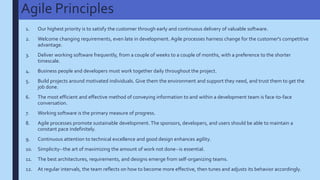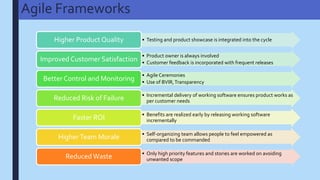Agile 101
- 1. AGILE 101 Introduction to Agile Methodology
- 2. Traditional Project Management - Waterfall Requirement Design Build Test Implement Support
- 3. Waterfall Project Management - Drawbacks ■ Difficult to cater to changing requirements ■ Working software produced very late; lack of customer feedback ■ Long delivery cycle; benefits are realized at the end of project ■ Lack of collaboration between business and IT ■ Lack of flexibility in meeting changing business needs ■ Difficult to measure progress within phases
- 5. Waterfall vs Agile Project Management Fixed Scope Est. Cost Quality Est. Schedule Waterfall Agile
- 6. Waterfall vs Agile Project Management Waterfall Agile Architecture Fixed before build starts Informal and incremental Integration At the end of test cycle Continuous Skill level Specialized Cross functional Management Project Manager as command and control leader Scrum Master as servant leader Software delivery Single - At the end of the project Multiple - Iterative and incremental Business interaction During requirement and UAT phases Throughout the project Responsibility of delivery Project manager Development team Benefits realization At the end of project Throughout the project Risk of failure High Low
- 7. Agile Manifesto Individuals and interactions Over Processes and tools Working software Over Comprehensive documentation Customer collaboration Over Contract negotiation Responding to change Over Following a plan While there is value in the items on the right, we value the items on the left more.
- 8. Agile Principles 1. Our highest priority is to satisfy the customer through early and continuous delivery of valuable software. 2. Welcome changing requirements, even late in development. Agile processes harness change for the customer's competitive advantage. 3. Deliver working software frequently, from a couple of weeks to a couple of months, with a preference to the shorter timescale. 4. Business people and developers must work together daily throughout the project. 5. Build projects around motivated individuals. Give them the environment and support they need, and trust them to get the job done. 6. The most efficient and effective method of conveying information to and within a development team is face-to-face conversation. 7. Working software is the primary measure of progress. 8. Agile processes promote sustainable development. The sponsors, developers, and users should be able to maintain a constant pace indefinitely. 9. Continuous attention to technical excellence and good design enhances agility. 10. Simplicity--the art of maximizing the amount of work not done--is essential. 11. The best architectures, requirements, and designs emerge from self-organizing teams. 12. At regular intervals, the team reflects on how to become more effective, then tunes and adjusts its behavior accordingly.
- 9. Agile Frameworks Scrum • Enables a small, cross- functional, self-managing team to deliver fast Kanban • Improves speed and quality of delivery by increasing visibility of work in progress, and limiting multi-tasking Scrumban • Limits work in progress like Kanban with Scrum ceremonies such as Daily standup Lean • Streamlines and eliminates waste to deliver more with less XP (Extreme Programming) • Develop robustly to ensure quality
- 10. Agile Frameworks • Testing and product showcase is integrated into the cycleHigher Product Quality • Product owner is always involved • Customer feedback is incorporated with frequent releases Improved Customer Satisfaction • Agile Ceremonies • Use of BVIR,Transparency Better Control and Monitoring • Incremental delivery of working software ensures product works as per customer needsReduced Risk of Failure • Benefits are realized early by releasing working software incrementallyFaster ROI • Self-organizing team allows people to feel empowered as compared to be commandedHigherTeam Morale • Only high priority features and stories are worked on avoiding unwanted scopeReduced Waste
- 11. Common misconception of Agile Unplanned and unstructured No documentation is required Not a disciplined approach Development is not predictable Not meant for large and complex projects Doesn’t work for distributed teams No design required


